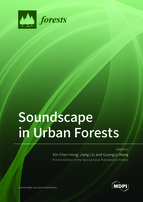Soundscape in Urban Forests
A special issue of Forests (ISSN 1999-4907). This special issue belongs to the section "Urban Forestry".
Deadline for manuscript submissions: closed (25 November 2022) | Viewed by 27560
Special Issue Editors
Interests: soundscape; lightscape; audio-visual interaction; urban planning; landscape design; signal processing; deep learning; augmented reality(AR)
Special Issues, Collections and Topics in MDPI journals
Interests: multi-sensory landscape experience and mechanism; soundscape design and soundscape resource management; landsenses ecology; ecological planning and design
Special Issues, Collections and Topics in MDPI journals
Interests: forest management; forest policy; land-use change; conservation; ecosystems
Special Issues, Collections and Topics in MDPI journals
Special Issue Information
Dear Colleagues,
The World Health Organization (WHO) to reduce citizens' exposure to community noise in urban and suburban areas. Urban forests contribute to a healthy environment for the public in high-density cities. Soundscape plays a positive health-related role in urban areas, especially natural soundscape in urban forests. The effects are not limited to psychological and physical rehabilitation, but also have ecological significance, such as protecting the acoustic environment for animal communication in forested areas. Additionally, soundscape perception is closely related to other perceptions, contributing to the visiting experience in urban forests. These facts demonstrate that soundscapes in urban forests have profound connotations worth further exploration.
Thus, we propose this Special Issue “Soundscape in Urban Forests”. We welcome submissions of original research articles, reports or technical notes, reviews, and mini-reviews covering, topics including but not limited to the following:
- Ecological pattern and process of forest soundscape;
- Boundary effects and perceptual topology;
- Natural soundscape and human health;
- Experience of multi-sensory interaction;
- Environmental behavior and cognitive disposition;
- Soundscape resource management in forests.
Dr. Xin-Chen Hong
Prof. Dr. Jiang Liu
Prof. Dr. Guangyu Wang
Guest Editors
Manuscript Submission Information
Manuscripts should be submitted online at www.mdpi.com by registering and logging in to this website. Once you are registered, click here to go to the submission form. Manuscripts can be submitted until the deadline. All submissions that pass pre-check are peer-reviewed. Accepted papers will be published continuously in the journal (as soon as accepted) and will be listed together on the special issue website. Research articles, review articles as well as short communications are invited. For planned papers, a title and short abstract (about 100 words) can be sent to the Editorial Office for announcement on this website.
Submitted manuscripts should not have been published previously, nor be under consideration for publication elsewhere (except conference proceedings papers). All manuscripts are thoroughly refereed through a single-blind peer-review process. A guide for authors and other relevant information for submission of manuscripts is available on the Instructions for Authors page. Forests is an international peer-reviewed open access monthly journal published by MDPI.
Please visit the Instructions for Authors page before submitting a manuscript. The Article Processing Charge (APC) for publication in this open access journal is 2600 CHF (Swiss Francs). Submitted papers should be well formatted and use good English. Authors may use MDPI's English editing service prior to publication or during author revisions.
Keywords
- natural soundscape
- ecological pattern of soundscape
- multi-sensory interaction
- soundscape resource management
- environmental behavior
- environmental health








